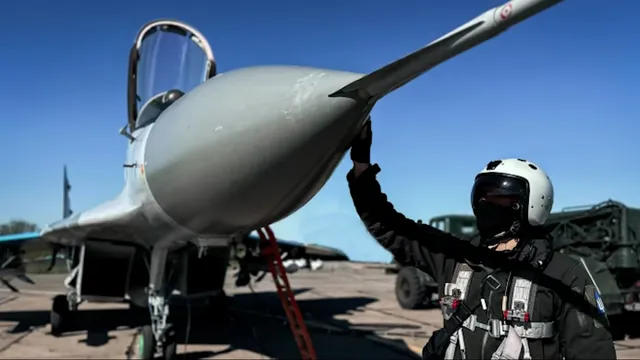
Ukraine successfully intercepts advanced Russian drone in night operation
2025-06-28 00:00- Ukrainian forces have developed specialized drone interceptor units to counter advanced Russian drone threats.
- Recent upgrades to Russian Shahed drones include enhanced electronic systems and submunitions for improved battlefield effectiveness.
- The ongoing conflict features a race for aerial superiority as both sides adapt their tactics and technologies.
Express your sentiment!
Insights
In late June 2025, Ukraine's Air Force showcased its resilience against increasingly sophisticated threats from Russian forces. The country has recently intercepted a Russian Shahed drone utilizing advanced technology, including AI targeting systems and anti-jamming capabilities. As the conflict escalates, these Iranian-designed drones pose a significant challenge due to their upgrades, which have made them more difficult to intercept. A MiG-29 pilot with the Sevastopol Tactical Aviation Brigade successfully downed this drone during a night mission, highlighting the essential role of specialized interceptor units being formed to meet the emerging aerial threat. The latest modifications to these Shahed drones are aimed at improving their effectiveness on the battlefield. Reports reveal the presence of advanced features, such as enhanced electronic systems with multiple antennas that enhance their resistance to jamming. Upgraded drones have been noted to carry submunitions that can spread over a wide area, increasing their potential for causing damage and complicating the defensive strategies employed by Ukrainian forces. The recent uptick in successful Ukrainian interceptions demonstrates the ongoing struggle and increased stakes involved in the conflict. In response to the evolving tactics employed by Russian forces, which include launching drones in pairs to thwart detection efforts, Ukrainian military officials are adapting their strategies to counteract these developments. The rise in Russian drone strikes has led to an alarming increase in the percentage of drones reaching their intended targets—up to 16% from earlier rates of just 6%. This shift necessitates a strategic reevaluation by Ukrainian forces, especially as they contend with new threats and changing battlefield dynamics. The ongoing fight against drone technology not only underscores the advancements made on each side but also reflects the broader context of the conflict. With both Ukrainian and Russian forces adapting their capabilities and tactics in real-time, the race for supremacy in aerial warfare continues to drive the conflict forward. As both sides engage in this high-stakes duel, understanding drone swarms and electronic warfare tactics has never been more crucial for maintaining battlefield advantages.
Contexts
The effectiveness of drone warfare in Ukraine is a multifaceted issue, influenced by technological advancements, tactical applications, and the unique geopolitical landscape of the region. The conflict, which escalated significantly in 2022, saw an increased reliance on drones for various military operations, ranging from surveillance and reconnaissance to precision strikes. This shift in warfare strategy is attributed to the flexibility and cost-effectiveness of drone technology, which has allowed the Ukrainian military to level the playing field against larger conventional forces. Drones have been instrumental in gathering intelligence, providing real-time data to inform military decisions, and executing targeted operations with minimal risk to personnel. One of the key aspects of drone warfare in Ukraine has been the use of commercial and military-grade drones. The adaptability of commercial off-the-shelf drones has enabled Ukrainian forces to deploy them for intelligence-gathering missions, often equipped with cameras and sensors to track movements of enemy troops and equipment. The integration of thermal imaging and night vision has further enhanced their effectiveness, allowing operations to continue even under low visibility conditions. Military drones, such as the Turkish Bayraktar TB2, have demonstrated significant capabilities in striking high-value targets, crippling logistical lines, and disrupting enemy operations, thereby showcasing a shift towards asymmetrical warfare strategies. However, the increasing reliance on drone warfare has also highlighted vulnerabilities. Anti-drone technologies have been developed and deployed by opposing forces, illustrating the arms race inherent in modern warfare. This development necessitates continuous advancements in drone technology and operational tactics to maintain effectiveness on the battlefield. Additionally, the ethical implications of drone strikes, including civilian casualties and the psychological impact on local populations, have spurred debates regarding the conduct of warfare in a digitally dominated environment. Ensuring compliance with international law and addressing humanitarian concerns has become an essential aspect of employing drone warfare in Ukraine. In conclusion, the effectiveness of drone warfare in Ukraine has profoundly altered the dynamics of the conflict, providing significant advantages in surveillance and precision strikes. As the technology continues to evolve, so too does the necessity for developing countermeasures and ethical frameworks to govern their use. The ongoing experiences in Ukraine may serve as a critical case study for future conflicts, where drone warfare's role becomes increasingly prevalent as armies adapt to modern warfare challenges.